The traditional embroidery of the Schwalm bodice (C) is not as elabotae as the borders of the Schwalm bodice (A) and the Schwalm bodice (B). The linen used has a 21–24/cm thread count. The picture shows the entire border in a photomontage.
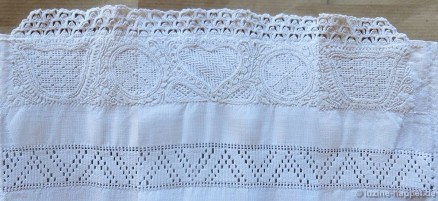 The space between needlelace and needle-weaving band has a width of about 7 cm. The space is not entirely filled with a design border.
The space between needlelace and needle-weaving band has a width of about 7 cm. The space is not entirely filled with a design border.
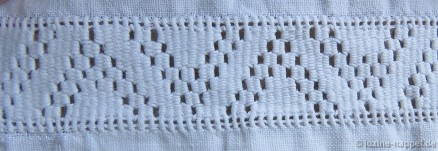 A seven-unit A-pattern was worked as a needle-weaving band. For more information about needleweaving bands – the different kinds and the different ways of working – please look to my book Fancy Hems.
A seven-unit A-pattern was worked as a needle-weaving band. For more information about needleweaving bands – the different kinds and the different ways of working – please look to my book Fancy Hems.
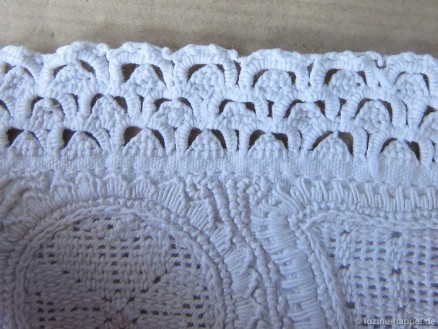 The bottom edge of the sleeve cuff has a needlelace edging of three rows of pyramids inside single scallops with connected picots outlining the needlelace border.
The bottom edge of the sleeve cuff has a needlelace edging of three rows of pyramids inside single scallops with connected picots outlining the needlelace border.
Between the needle-weaving band and the needlelace, a strip of linen remains unembroidered, and a band was embroidered with Schwalm whitework. If you look closely, you will see you many tendrils between the motifs.
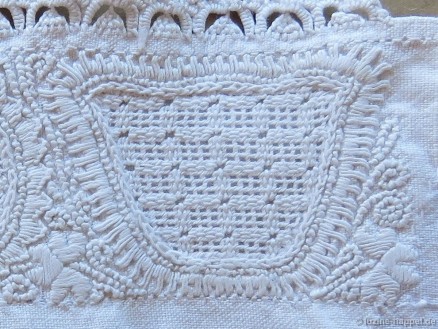 The tulip was outlined with 2 short-2 long embellishment. The shape was filled with an openwork pattern (cut 2, leave 2) with a Cable stitch grid. Into the grid a needle weaving pattern was worked.
The tulip was outlined with 2 short-2 long embellishment. The shape was filled with an openwork pattern (cut 2, leave 2) with a Cable stitch grid. Into the grid a needle weaving pattern was worked.
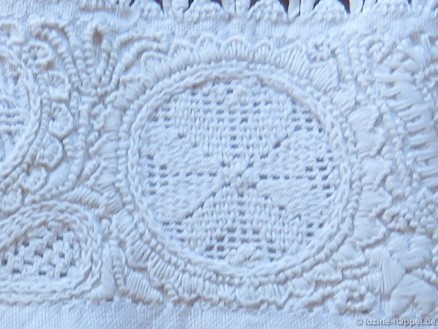 The circle was outlined with knife points with Blanket stitches. The shape was filled with an openwork pattern (cut 2, leave 2) with a Cable stitch grid. Into the grid a needle weaving star pattern was worked. It is notable, that thick thread was used for the needle weaving and that the squares of the grid were not filled very well.
The circle was outlined with knife points with Blanket stitches. The shape was filled with an openwork pattern (cut 2, leave 2) with a Cable stitch grid. Into the grid a needle weaving star pattern was worked. It is notable, that thick thread was used for the needle weaving and that the squares of the grid were not filled very well.
The star pattern is also suitable to work an other ornament for trimming the tree.
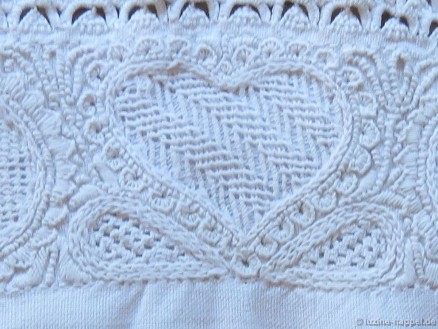 The heart was outlined with Blanket stitch half-eyelet scallops.
The heart was outlined with Blanket stitch half-eyelet scallops.
The shape was filled with a Limet filling pattern with Satin stitch bars worked in a stair-step manner. It is noticable, that the center of all patterns is not worked mirrored. Whereas the both small leaves on bottom of the heart are worked mirrored. They are filled with an openwork pattern without a Cable stitch grid. Rose stitches were worked into the shapes. The spaces between the motifs were densely filled.
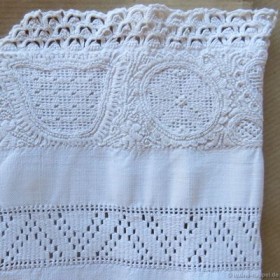


Leave a Reply